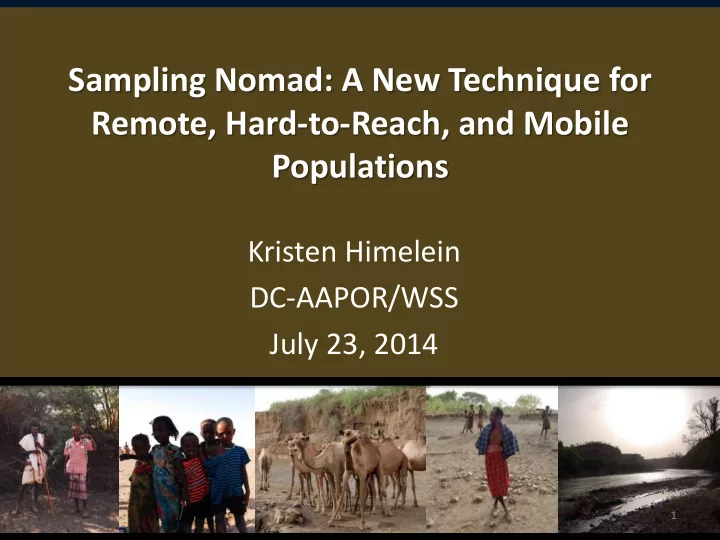

Sampling Nomad: A New Technique for Remote, Hard-to-Reach, and Mobile Populations Kristen Himelein DC-AAPOR/WSS July 23, 2014 1
Paper • With co-authors Stephanie Eckman (Institute of Employment Research, Nuremberg, Germany) and Siobhan Murray (World Bank Development Economics Research Group) • Published in the Journal of Official Statistics (June 2014) 2
Research Objectives • Use an alternative sampling approach to reach pastoralists • Are we able to capture populations missed by a dwelling based sampling frame? • How do our figures compare with other sources of information? 3
Background • Livestock play integral role in livelihoods of vulnerable populations – Main source of food and transportation – Store of wealth – Coping mechanism in response to shocks • Populations difficult to survey – Often pastoralist or semi-pastoralist • HH based samples may not be sufficient 4
Location: Afar, Ethiopia • Afar, Ethiopia highly pastoralist • More than 40 percent of respondents reported owning 10 or more cattle in 2009 Agricultural Sample Survey. – Cattle, camels, goats • Bounded by – national borders north & east – mountains to the west – ethnic differences 5
Random Geographic Cluster Sampling [RGCS] • 1 st stage: select random geographic points • 2 nd stage: survey all eligible respondents within given radius • Similar designs used: – Agricultural statistics agencies (ex: USDA) – Livestock studies in developing world (Cameron, 1997; Soumarea et al, 2007; von Hagen, 2002) – Surveys of forests (Husch 1982; Roesch et al 1993) 6
Stratification • Strata Inputs: land cover (towns and settled agriculture), distance to water, vegetation index
Strata Definition Expected Radius 1 Towns High 0.1 km 2 Settled agri. areas, commercial farms Low 0.5 km 3 Within 2 km of major river or swamps High 1 km 4 Within 10 km of major river or swamps Medium 2 km 5 Remainder Low 5 km 8
Stratification 9
Stratum 3 – High
Stratum 5 – Low
Field Work • Selected points pre-loaded on GPS – Alarm indicated when interviewer inside radius • Interview all eligible respondents within radius – Only HHs with livestock eligible – Livestock questions related to cattle, camels, goats • Ownership, vaccination, theft, death, etc. 14
Base Weights (1) • Inverse of probability of selection • But what is probability of selection of unit i ? i 15
Base Weights (2) • All points that lead to interviewer finding i i • If any of these points selected, i selected 16
Base Weights (3) • Probability of selection is 1 – (prob. that none of these points selected) 𝑑 𝜌𝑠 2 𝜌 𝑗 = 1 − 1 − 𝑢𝑝𝑢𝑏𝑚 𝑏𝑠𝑓𝑏 c is number of points selected 17
Base Weights (4) • Stratification complicates probabilities Stratum 1 Stratum 2 r 2 r 1 X 18
Base Weights (5) • Stratification complicates probabilities Stratum 1 Stratum 2 X 19
Weight Adjustment (1) • Teams did not always visit entire circle • Two measures – Supervisor report – Viewshed measures 20
Weight Adjustment (2) • Viewshed: High resolution elevation data needed to look at terrain effects on complete site visualization 21 Source: ASTER GDEM v2 (30 m)
Weight Adjustment (3) • Should we adjust weights? – No if we think area not covered because flooded or too thickly covered in vegetation for animals – Yes if we think that areas were not covered because of time limitations / laziness 1 • Adjustment: 𝑥 𝑗 = 𝑐𝑥 𝑗 ∗ % 𝑝𝑐𝑡𝑓𝑠𝑤𝑓𝑒 • 2 sets of weights: baseweight, adj weight 22
(ABRIDGED) RESULTS 23
Implementation Challenges • Field workers unaccustomed to technique • Unexpected challenges – Early start to rainy season – Ethnic conflict / kidnapping – Volcanoes – River crossings – Trouble with vehicles 24
Results of Data Collection (1) • 102 circles canvassed – 59% contained at least 1 HH with livestock • 784 households with livestock interviewed (9 excluded for being outside radius) • Total livestock found per circle represented on map
Results of Data Collection (2) • 3,698 individuals living in households owning livestock • 127 reported having no permanent dwelling, (approximately two percent weighted estimate of the livestock-holding population in Zones 1, 3, 4, and 5). • All but five of the individuals without a permanent dwelling lived in households in which all members are completely nomadic. 26
Conclusions • RGCS can be implemented in a low capacity environment with inexpensive hardware – though not without some difficulties. • RGCS does in fact capture nomadic populations • Necessary to incentivize interviewers to elicit a ‘high effort’ response. • It is likely that RGCS has under-estimated the total livestock population in Afar, but this still may be more accurate than those produced by the census-frame ERSS survey. 27
Contact: Kristen Himelein khimelein@worldbank.org Stephanie Eckman stephanie.eckman@iab.de Siobhan Murray smurray@worldbank.org 28
Results of Data Collection Circles Visited Description Points HHs without Circles Livestock 1 Towns 10 10 69 4 Settled agri. areas, 2 15 14 113 8 commercial farms within 2 km of 3 60 49 229 24 major river within 10 km of 4 30 22 182 6 major river 5 Remainder 10 7 191 1 Total 125 102 784 43 29
Recommend
More recommend